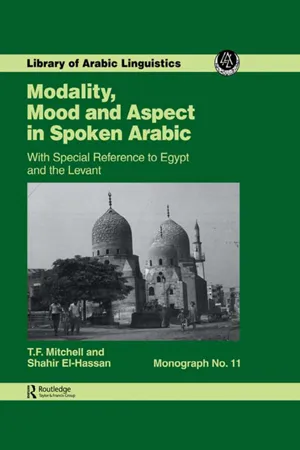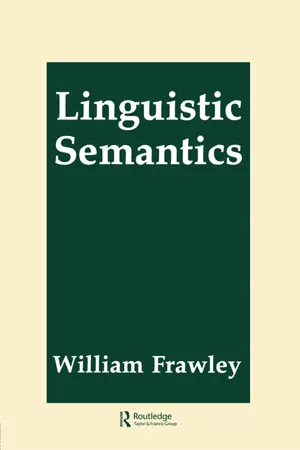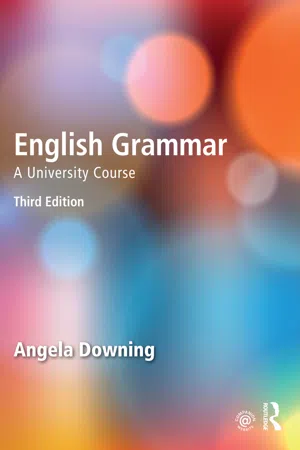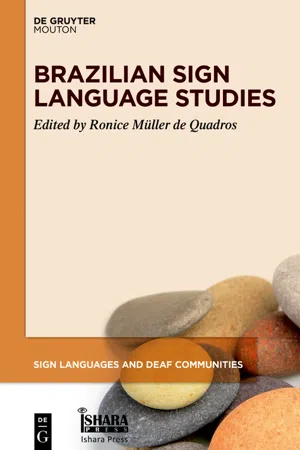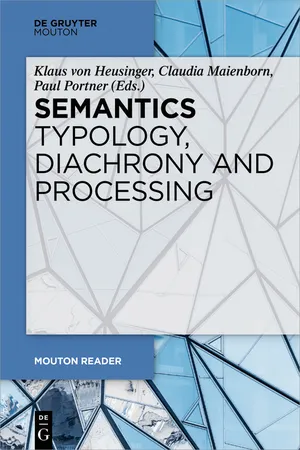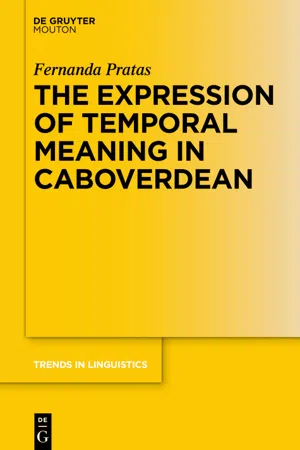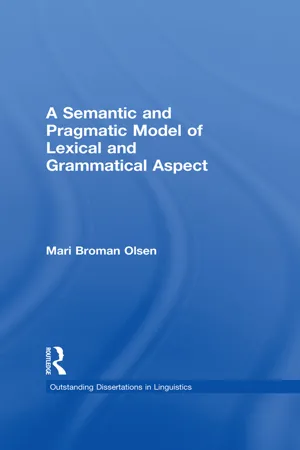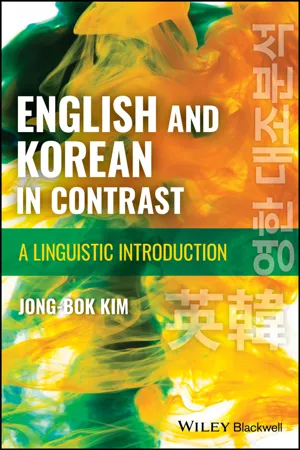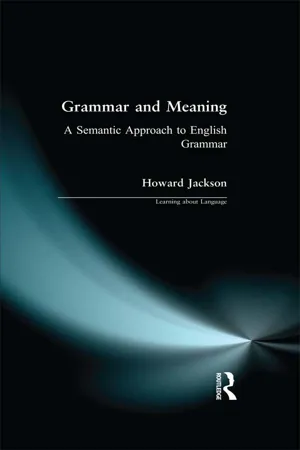Languages & Linguistics
Tenses
Tenses in grammar refer to the different forms of verbs that indicate the time of an action or state. In English, there are three primary tenses: past, present, and future. Each tense can be further divided into simple, continuous, perfect, and perfect continuous forms, allowing for precise expression of time and duration in language.
Written by Perlego with AI-assistance
Related key terms
Related key terms
1 of 4
Related key terms
1 of 3
12 Key excerpts on "Tenses"
- eBook - ePub
- Mitchell(Author)
- 2013(Publication Date)
- Routledge(Publisher)
states are seen from varying standpoints of changelessness. The grammatico-semantic representation of events and processes as indivisible and without extent is non-aspectual; at least as far as Arabic is concerned, aspect is a matter of duration, of (spatio-) temporal continuity and flow, and interruptions thereto. As such it contrasts with its locative counterpart, tense, and it is to this contrast that we shall first turn. For the time being, suffice it to say that the language especially grammaticalizes stative (in particular, perfect (participial) state), aspects progressive, and habitual (/iterative). Although other aspectual categories to which we refer are regularly discernible, it is to those just mentioned that we shall perforce devote most of our attention.3.2 Aspect and tense
3.2.1 Relation to timeThe fact that both aspect and tense primarily relate verbal form to concepts of time has often led to confusion, and the scope of both categories still provides controversial issues among grammarians. It seems, however, to be generally agreed that tense is an inflectional category which locates the action or state expressed by a verb at a time relative to the moment of speaking. Time is, of course, a non-linguistic concept which is usually thought of in terms of subdivisions past, present, and future. Tense in Arabic is largely a matter of morphological paradigms of forms differentiated first and foremost for person, and the two paradigms in question are not at all congruent with divisions of clock or universal time. Of the two Tenses, the past, as illustrated by šαrαḥ “he explained” in1 ’ilmudarris šαrαḥ iddars (il’usbuu° ilmααĐi)2 “The teacher explained the lesson (last week)” places the action expressed by the verb at a time prior to the moment of utterance. On the other hand, the nonpast, illustrated by the corresponding form byšrαḥ in2 ’ilmudarris byšrαḥ iddars“The teacher explains or will explain the lesson” locates the action at a time best described negatively as not prior to the moment of utterance. There are indeed in Levantine usage cases of the nonpast where the tense has some past relevance, as we shall see. At all events, it should be emphasized that the nonpast does not assign the action in 2 to a time contemporaneous with the moment of speaking and it would be quite misleading to use the term “present” with its implications of contemporaneity. It is only in contexts of immediate report, for example an instructional description of an experiment taking place or a radio sports commentary, that the nonpast tense can be said to locate the action at a time contemporaneous with the time of utterance, as in 3 and 4 - eBook - ePub
- William Frawley(Author)
- 2013(Publication Date)
- Routledge(Publisher)
88.1. INTRODUCTIONTense and Time
In this chapter, we inquire into how language structures and encodes time. The analysis of linguistic time has an involved history, with logical and structural/typological camps (Comrie 1985; Dahl 1985; Prior 1967; Reichenbach 1947; Rescher and Urquhart 1971). In our own foray into the matter, we try to extract the accepted findings from both practices in an attempt to present the necessary elements of any linguistic system of time.We restrict our study of time to the mechanism that assigns time to events: tense. This focus on tense affords us a number of advantages. Most immediately, it allows us to contrast the internal temporal contour of events with their nontemporal internal contour, aspect, discussed at length in the previous chapter.If aspect is the way that an event patterns within or over a time frame, tense is the way an event is explicitly indexed for a time frame, the grammatical and morphological means that a language uses to locate an event in time. Aspect encodes the nondeictic contour of events; tense signals the deictic contour insofar as such concepts as ‘location in time’ and ‘relative order’ are deictic because they require reference points for their determination. We thus get considerable use out of our previous discussion of deixis now that we are required to apply it to the structure of events and their temporal location.Our investigation proceeds as follows. First, we spell out the basics of time and its encoding in any language. Here, we discuss the canonical model of time that underlies linguistic expressions and the elemental deictic requirements of any tense system. Thereafter, we see how the deictic structure of tense translates into linguistic form. The deictic reference point and located point relate to how languages assign absolute and relative values. Remoteness between the reference point and the located point determine the ways that languages choose to measure temporal distance, either through simple extension, as a vectorial system, or through intervals, as a metrical system. - eBook - ePub
Grammar, Meaning, and Concepts
A Discourse-Based Approach to English Grammar
- Susan Strauss, Parastou Feiz, Xuehua Xiang(Authors)
- 2018(Publication Date)
- Routledge(Publisher)
7 The Grammar of Time, Fact, Habit, Changeability, Permanence, Sequence, and Relevance in DiscourseTense and Aspect
Figure 7.1 “When you’re trying to fall asleep, does it ever feel like your thumbs are still texting?”© Randy Glasbergen. Reproduced with permission of Glasbergen Cartoon Service.In Chapter 6 , we discussed verbs and their functions and power in discourse. In this chapter, we introduce tense and aspect as features of grammar that infuse verbs with time reference and perspectival detail about states and events that verbs express.Tense relates to the time of a situation or event. In English, there are three categories of grammar that establish a broad frame of basic time reference—present tense, past tense, and future—but only present tense and past tense are formed with morphological inflections (see Chapter 2 ). Future time is expressed with the modal will (see Chapter 8 ).Aspect works within these temporal frames of time to provide additional detail revealing perspectives and viewpoints with respect to how those events, processes, and actions unfold; what relationship they have with their time of unfolding; and what relationship they have with other events and times within discourse (Bybee, 2008; Bybee et al., 1994; Comrie, 1976, 1985; Fenn, 1987; Hirtle, 1967; Hopper, 1982; Langacker, 2008; Leech, 1971; Radden & Dirven, 2007).There are four grammaticalized aspects in English: simple, progressive, perfect, and perfect progressive. These four aspects interact with the three Tenses to create 12 combinations of tense and aspect forms. That is, grammatical aspect and tense are inextricably interrelated. Later, we will discuss the 12 possible tense and aspect categories for English in more detail. - eBook - ePub
English Grammar
A University Course
- Angela Downing(Author)
- 2014(Publication Date)
- Routledge(Publisher)
- Tense is the grammatical expression of the location of events in time. It anchors an event to the speaker’s experience of the world by relating the event time to a point of reference. The universal, unmarked reference point is the moment of speaking – speech time. In narrative, a point in past time is usually taken as the reference point.
- English has two Tenses, the present and the past, the past being the marked form, both morphologically and semantically.
- The basic meaning of the present tense is to locate a situation holding at the present moment. This may be an instantaneous event (I promise to wait), a permanent state, a fact held as true (The law of gravity is universal), or an habitual occurrence (He works in an office). Secondary meanings of the Present include reference to past and future events, ‘historic present’ (This man comes up to me . . . ) and the quotative (and she goes /she’s like ‘I don’t believe it’ ).
- The past tense primarily refers to a definite event or state that is prior to utterance time. Its secondary uses refer to a present event or state as hypothetical (If I were you ).
- English has no verbal inflection to mark a future tense. Instead, English makes use of a number of forms to refer to future events.
- Finite clauses in English can be marked for either tense or modality but not both. Verbs marked for tense are said to be ‘tensed’. Non-finite clauses are not tensed.
41.1 The Meaning of Tense
Tense is the grammatical expression of the location of events in time. It anchors (or ‘grounds’) an event to the speaker’s experience of the world by relating the event time to a point of reference. The normal, universal point of reference is the moment of speaking – speech time , what has been called ‘the inescapable and constantly changing now - eBook - ePub
- Bas Aarts, April McMahon, Lars Hinrichs(Authors)
- 2020(Publication Date)
- Wiley-Blackwell(Publisher)
10 Tense in English LAURA A. MICHAELIS10.1 Introduction
Humans conceive of time in terms of space, as shown by the language that we use to talk about temporal relations: we habitually speak of stretching out or compressing an activity, heading toward the future, returning to the past, and so on (Whorf 1956 ; Lakoff and Johnson 1980 ; Binnick 1991 ; Chapter 1 , Casasanto and Boroditsky 2008 ). When describing the meanings of the Tenses, linguists have relied on a specific instantiation of the space–time analogy: the TIMELINE . The timeline is a line (or, equivalently, an ordered set of points) that is unbounded at either end and segmented into three parts: the past, the present, and the future. While we can describe various ordering relations among points on the timeline (as when we describe two events as simultaneous), only one type of relation counts as a tense relation: that which includes the time at which the linguistic act is occurring. As Lyons states (1977, p. 682), “the crucial fact about tense […] is that it is a deictic category. A tensed proposition, therefore, will not merely be time‐bound, […] it will contain a reference to some point or period of time which cannot be identified except in terms of the zero‐point of the utterance.”Like other linguistic reference points that are anchored in the “here and now,” the temporal zero‐point can, under the appropriate conditions, be identified with times other than the time of speaking or writing. One such case is that in which a writer uses the time of message interpretation, rather than the time of message construction, as the zero‐point (Declerck 1991 , p. 15). For example, a note writer may choose the formulation I’m across the hall rather than I will be across the hall. The shifting of the temporal zero‐point also occurs in subordinate clauses, both temporal and conditional, as in, for example, When/if you have finished your test, [raise your hand]. Here, a present‐perfect predication is used despite the fact that its reference point is located in a (hypothetical) future rather than at the time of speaking (McCawley 1981 - eBook - ePub
- Ronice Müller de Quadros(Author)
- 2020(Publication Date)
- De Gruyter Mouton(Publisher)
To this end, this research develops an analysis to describe elements in the grammar system of Libras to denote tense and aspect – far more than just a short list of lexical items, as has been assumed so far for this language. Within the analysis, morphological inflections and compositional relations between tense and aspect show that such a system is much richer than expected. The data shown here is obviously just a sample of tense/aspect forms, and the examples were chosen for being the most recurrent among Libras speakers. Thus, the first section presents a set of examples analyzed in order to describe the parameters involved in the temporal reference system in Libras, regardless of any theoretical proposition for the tense category. In the second section though, a theoretical model is provided, along with a conceptual definition for the aspect category, and its organizational rules in Libras.2 Description of tense signs
Reichenbach’s (1947) works have been constantly revisited and reconstructed when it comes to tense category description in natural languages. In summary, his proposition poses a model based on three primitive temporal entities: S, the speech time, regarding the moment a sentence is uttered; E, the event time, referring to the time that the event which the sentence is about takes place; and R, the reference time. Thus, tense is still defined as a deictic category, since it establishes localization in time, taking the speech time as reference point.Klein (2007[1994]) revisits and widens Reichenbach’s model, by rearranging it into a description of how the tense category is organized. To clarify the concepts related to this new model, we have to consider that temporality may, as the author defends, be expressed in natural languages by: grammar inflections, tense characteristics that are inherent in the verbs and/or their complements, adverbs, and discursive organization principles. Klein also asserts that there are four possible parameters to describe temporal meaning of a tense-form: (1) the deictic, that takes the moment of speech as reference and places the present tense as simultaneous, the future as posterior and the past tense as anterior; (2) the refined deictic, in which it is possible to observe time gradation, such as distant past, very distant past and remote past; (3) the deictic-relational that establishes relations between the moment of speech and the moment of the event (expressed by verb lexicality), without losing deictic temporality given by the moment of speech; (4) the non-deictic and non-relational, in which the tense inherent in the verb marks if the event is expressed as complete or incomplete, dismissing the temporality relation with the moment of speech. Klein (2007[1994]) draws attention to the fact that these parameters are not opposable – they are actually compatible, because they can be compositionally combined in one system. In his words: - eBook - ePub
- Klaus Heusinger, Claudia Maienborn, Paul Portner(Authors)
- 2019(Publication Date)
- De Gruyter Mouton(Publisher)
The present tense is quite flexible. In many languages, including English and Romance, the combination of present tense and past adverbial—known as the ‘historical present’—can be used to talk about the past, typically in a narrative context. Such forms are often said to make narration vivid, by presenting past events as present, as in (25). The historical present can alternate with the past tense, or it can appear in sustained sequences.(25) Yesterday something unexpected happened. This man walks up to me and he says … The present tense can also be used to talk about the future, and can even appear with future adverbials, as in the use of the simple present in (26a), or in the construction known as the periphrastic future (26b), frequently found across languages. Yet another use of the present is to express general truths in sentence that are taken to be timeless (26c).
This flexibility shows that the present tense has a relational value of simultaneity, allowing it to be simultaneous with an explicitly given time as well as SpT. The past tense can be used to convey politeness, as in (27):(26) The train leaves tomorrow at 2pm. Tomorrow the train is going to arrive. The Texas redbud blooms in the early spring.
Here the past tense sets up a distance between speaker and hearer, conveying respect for the hearer.(27) I wanted to ask you a question. 4 Tenseless languages
4.1 Temporal information in language: A classification
Languages can be classified according to how they convey temporal information. A three-way classification allows for the variation that we find: there are fully tensed languages, mixed-temporal languages, and tenseless languages. Tensed languages have been discussed above. Mixed-temporal languages have some of the characteristics of tensed languages. They have inflectional morphemes and/or temporal particles and clitics that give direct temporal information. However, these forms are syntactically optional and do not participate in other grammatical processes. Thus a given sentence may or may not convey temporal information; Navajo and other Athabaskan languages are of this type. Finally, there are languages without temporal inflections or particles, such as Mandarin Chinese and Thai, some Mayan languages, and many others (Dahl & Velupillai 2005 - eBook - ePub
- David Kilby(Author)
- 2019(Publication Date)
- Routledge(Publisher)
Chapter One Tense and Aspect The basic structural form of the English verb group is quite well known and poses few problems; furthermore, the details have been analysed many times in the literature (from virtually every theoretical perspective). We can analyse it as follows, omitting the specification of which suffixes are appropriate on the various elements: This formula begs certain questions: how are the suffixes specified? does the order of elements in the verb group need to be specified arbitrarily, or does it follow from more general principles? what is the categorial status of all of these elements? These are questions that have been beaten to death in the transformational literature, their major characteristic being that they bear on the types of grammatical device available in linguistic theory. I shall not be concerned with these questions, but rather with the meaning of these various options, and the problem of their compatibility with different verbs. There is a useful distinction to be made between 'tense' and 'aspect', both of which are found in English. Tense is a category which primarily involves the time of the event or state specified by the verb relative to the moment of utterance; aspect, on the other hand, is notoriously difficult to define: it is perhaps best to see it as focusing round such concepts as completion, repetition, habituality, etc. Look first at the category of tense in English: any of the positions marked 'suffix' in (1) are in principle available to be filled with a tense marker (which on the most regular of verbs corresponds to –0,– s or – ed). It is sometimes assumed that English has three Tenses – past, present and future – but in fact there are only two relevant formal distinctions in English (–0 and – s are of course a single option, the difference between them not being a matter of tense, but rather the person and number of their subject noun phrase) - Fernanda Pratas(Author)
- 2021(Publication Date)
- De Gruyter Mouton(Publisher)
chapter 1, to complex ideas in both the philosophical and psychological sense (as conception and perception are sometimes difficult to tell apart). Klein later suggests that it “should be replaced by the more general notion of clause-external temporal structure, to which situations described by a sentence can be linked” (Klein 2009: 48).There is a multitude of ways to express the linkage between the lexical content and TT, and then between TT and TU, and Klein (1994) presents various examples of this complexity, for which some languages have morphological distinctions (these are typically from the Indo-European family) and others do not. And so, given that he is talking about language universals, when he defines tense in the terms pointed out above, he refers to the relation itself (Tenses are “abstract temporal relations”; Klein 1994 : 123), not to morphological verb markings. In another work he even states that tense, in the sense of verbal inflection, “is not only to be separated from time—it is not even a [sic] particularly important for the expression of time. Many languages do not have it at all, and in those languages that do have it, it is largely redundant” (Klein 2009: 43).824.1.2 Tenseless languages
Tenselessness is here taken as the lack in a given language (or clause) of dedicated grammatical markings for that relation between TT (topic time) and TU (time of utterance). This is in line with most studies on this issue, which thus defend the absence of tense morphemes without defending that a tense meaning, in the above sense, is also absent from those languages (there is at least on exception, though).83- Mari B. Olsen(Author)
- 2016(Publication Date)
- Routledge(Publisher)
chapter 1 , I distinguish between semantics and conversational pragmatic implicature on the basis of cancelability: semantic meanings are uniform and uncancelable, whereas conversational implicatures are variable and cancelable (Grice 1975). A proper understanding of semantic and pragmatic properties allows tense to be semantically described as a temporal relation between a reference time (RT) and a center (C), the location of which is pragmatically implicated. This definition eliminates the traditional and problematic distinction between absolute and relative tense in favor of the independently necessary distinction between tense and grammatical aspect: all absolute Tenses and some relative Tenses are classified as Tenses, because they assert a consistent semantic relation between RT and C; other relative Tenses are more properly characterized as grammatical aspect.Comrie (1985:36) defines an ABSOLUTE TENSE as one which “includes as part of its meaning the present moment as a deictic centre; whereas relative tense refers to a tense which does not.”1 According to this definition, absolute Tenses are defined with respect to the present, namely the ST (or time of writing) (Comrie 1985:2; Reichenbach 1947), as represented in (1) .2(1) Absolute past tense is therefore used for situations at any time before the ST, as in (2a) , present tense for those concurrent with ST, as in (2b) , and future tense for those subsequent to it, as in (2c) .(2) (a) Jeanette yawned/was old. (past) (b) Jeanette yawns/is old. (present) (c) Jeanette will yawn/be old. (future) In contrast, according to one definition used by Comrie, Relative Tense locates a RT with respect to one of several pragmatically determined times (Comrie 1985:36, cf. 1–2; Anderson 1973:40; Dahl 1985:25). Relative tense is also known as secondary tense (Fanning 1990:17), or secondary aspect (Fanning 1990:85). Comrie cites the Latin participles as examples: the past, present, and future participles locate a RT that is, respectively, past, present, or future, but relative to the time denoted by the main verb rather than the ST. In (3)- eBook - ePub
English and Korean in Contrast
A Linguistic Introduction
- Jong-Bok Kim(Author)
- 2024(Publication Date)
- Wiley-Blackwell(Publisher)
6 Tense and Aspect: Describing When and How a Situation Happens6.1 Ways to Describe an Event
Describing a situation or event involves at least three dimensions: tense, aspect, and mood (TAM). These three concepts are grammatical categories realized in the verbal structure, either morphologically or syntactically. Semantically, they all have something to do with time. Tense tells us when a situation occurs, and aspect tells us how it occurs or how the speaker views it in terms of its continuity (ongoing) or completeness. Mood refers to the attitude about the situation expressed by a given sentence. It tells us whether the stiuation is actually happening, possibly happening, or being commanded to happen.We can interpret tense as referring to a temporal point when an event takes place or a state holds, as represented on a linear timeline:- (1) Three points of tense:
As represented here, three reference points for tense indicate when a situation happens or holds. Each language has a different way of describing these three temporal points. For instance, to describe an event that happened earlier, English typically uses the suffix ‐ed, and Korean uses the suffix ‐ess/ass:- (2)
- It rained yesterday.
-
어제 비가 왔다. ecey pi‐ka o‐ass‐ta yesterday rain‐NOM come‐PST ‐DECL ‘It rained yesterday.’
Aspect, unlike tense, refers to how an event is happening from the speaker's point of view. It describes the internal temporal constituency of a situation. That is, aspect describes whether a situation is ongoing or completed. An ongoing situation can have three different points, represented with circles on the linear timeline:- (3) Three types of ongoing processes:
Again, languages adopt different grammatical apparatus to describe these three types of ongoing situations. In English, the most typical way is to use the be + V‐ing - eBook - ePub
Grammar and Meaning
A Semantic Approach to English Grammar
- Howard Jackson(Author)
- 2014(Publication Date)
- Routledge(Publisher)
CHAPTER 4Specifying States, Eventsand Actions: Tense, aspectand modality
In Chapter 1 we generalised about the kinds of things which we talk about by introducing the notion of situation types. We recognised three broad types of situation — STATE, EVENT, ACTION — with various subtypes. States, events and actions are represented in the grammar of the language by verbs. When we use a verb in a sentence there are a number of additional pieces of information which we may or must specify. For example, we have to choose whether to use a verb in the present tense or the past tense (see Chapter 1 ); it must appear in one or the other. In this chapter we are going to look at these specifications of states, events and actions. They have broadly to do with the setting of situations in time, and with the possibility or necessity of situations.Time
Time is an essential element in probably all actions and events. We specify when something took place relative to the time of speaking or writing, and we may specify other time-related factors, such as whether an event (or action) was instantaneous or lasted over a period of time. States, too, are specified for time, though some may be considered to be ‘timeless’, e.g.
Index pages curate the most relevant extracts from our library of academic textbooks. They’ve been created using an in-house natural language model (NLM), each adding context and meaning to key research topics.
Explore more topic indexes
Explore more topic indexes
1 of 6
Explore more topic indexes
1 of 4
